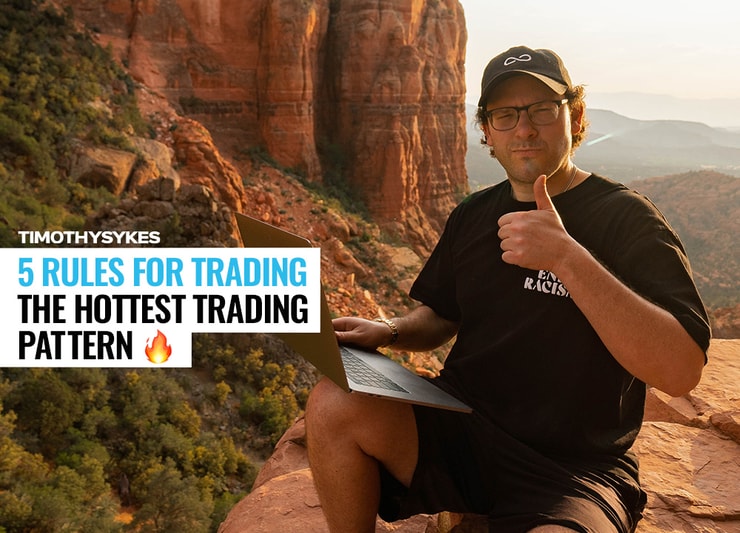I know I posted this a few days ago:
PATTERN THAT'S WORKING WELL RIGHT NOW: Focus on buying any heavily shorted stocks that are breaking out near the market open, worked well with $PXMD the other day, $LIFW yesterday & now $TPST today…very simple, but very effective, giant thanks to the over-crowded short niche!
— Timothy Sykes (@timothysykes) November 9, 2023
But it’s worth repeating.
Why?
Because it’s still working…and pumping out some massive gains for traders.
What’s even more impressive…is that it’s rather simple to learn.
Now, I don’t know how long this will continue…but if you’re in search of making quick short term profits…then this is something you must try to master.
Here are my top five rules.
Table of Contents
- 1 The Hottest Pattern Worth Trading Right Now
- 2 Rule #1: Look For The Worst of The Worst Stocks
- 3 Rule #2: Look For Big Percent Movers + Heavy Volume
- 4 Rule #3: Don’t Trust These Stocks
- 5 Rule # 4: Don’t Dip Buy The Backside
- 6 Rule #5: Don’t Get Overly Aggressive With These Trades
- 7 Unlock the Secrets of Short Squeeze Mastery with Tim Sykes! 🔥
The Hottest Pattern Worth Trading Right Now

I’m not the world’s biggest fan of trading short squeezes.
They’re volatile, not always clean, and they sometimes make me feel uncomfortable.
However, this is where the largest opportunities lie right now.
And last I checked I don’t control the markets…so I’ve forced myself to adapt.
📈 NEW BLOG POST: https://t.co/0DvI4z6Lub
What $LIFW, $PXMD, and $NVOS have in common 🤔
"We have a new hot theme on our hands!
Yesterday cemented the theme with the third stock with the same news having a massive day.
I didn’t like it the day before because I don’t like to… pic.twitter.com/q1OyFgQJmt
— StocksToTrade (@StocksToTrade) November 9, 2023
You can find out how I’ve been trading these short squeeze plays when you visit my Profit.ly.
Now on to my five rules for trading them.
Rule #1: Look For The Worst of The Worst Stocks

If you’re coming from the investing world this will completely surprise you.
Why?
Because some of the biggest short squeezes are occurring in the absolute worst stocks.
The reason is because we’re seeing an overabundance of short sellers pile into these stocks.
That’s right…
What was once a very easy trade…short selling crappy stocks…has gotten flipped around.
Now, the risk-reward has shifted…and it’s actually better to play the long side.
Take the ticker APLD for example…
During the day two short reports came out trashing the company.
You’d think with all the negative news it would crash, right?

It actually did the opposite.
Why?
That’s what happens when shorts are overcrowded, and shady brokers are over allocating shares to borrow.
We’re seeing squeeze after squeeze.
Even AMC…which is notorious for rug pulls, created a dip buying opportunity a few days ago.
More Breaking News
- QuantumScape Shares Drop: Analyzing Market Reactions and Future Speculations
- Stryker’s Big Move: Is Inari Medical Ready for a New Chapter?
- Richtech Robotics’ Stock: Is the Steep Fall an Investment Chance or a Risky Bet?

Rule #2: Look For Big Percent Movers + Heavy Volume
Most people when they think short squeezes…they assume it’s a stock with high short interest.
But I’ve never been able to find accurate data pertaining to it. And because of that…I don’t use it.
I think price action is KING.
Look where the volume is…and you’ll likely see what stocks shorts are being trapped in.
Because we all know…it’s not fundamentals moving these stocks.
Rule #3: Don’t Trust These Stocks

When you are trading the trashiest stocks you don’t want to keep your eyes off them.
At any point they can fall off a cliff…announce a stock offering…or get exposed.
In fact, using stops in these kinds of stocks is often a bad idea because they can swing up and down so violently.
That’s why I’m never aggressive with my entries.
And I never try to get greedy.
Eventually the shorts will be right…they might be a day, two days, or even three days early…but these stocks will crash.
Rule # 4: Don’t Dip Buy The Backside
One thing newbies do that gets them wrecked is they buy the backside of a move.
What’s that?

Source: etrade
Check out LIFW….it rallied hard for an entire day…
And the next day it gave a lot of those gains.
You don’t want to be a buyer on day two when the stock is puking.
That’s what it means to buy the backside.
It’s better to buy the dip on day one of the move…
Even better…buy as the stock is making a breakout high.
But stay away from trying to buy the dip after the stock has had a massive sell-off.
Remember, almost all these stocks will come back to their rightful place.
Rule #5: Don’t Get Overly Aggressive With These Trades

I’m trading these setups relatively small.
I also understand that my timing might not be perfect the first time. In other words, I may get into the same stock 2 or 3 times.
In order for me to do that though, I must keep my losses small. And I must position size accordingly.
These are wild stocks making wild moves.
Be smart with your position size. Even though they are making massive spikes, I’m still trying to trade them conservatively.
Unlock the Secrets of Short Squeeze Mastery with Tim Sykes! 🔥

Tired of missing out on the market’s wildest rides? Want to learn the patterns that lead to massive gains? Look no further!
🚀 Gain exclusive insights into the short squeeze phenomenon.
🚀 Discover my top rules that lead to trading triumphs.
🚀 Get actionable strategies for identifying and trading high-potential stocks.
With my team’s guidance, you’ll learn not just to trade, but to trade smart. We’re talking about strategies that have been refined in the heat of the market, proven to pinpoint opportunities like the ones that led to:
📈 A 370% rally in RNAZ
📈 A 2300% surge in VTGN
📈 An astonishing 3,733% leap in TPST
We’ll show you how to identify the worst stocks ripe for a squeeze, how to read volume and price action cues, and most importantly, how to manage your risk to stay in the game.
🔥 Learn why you should never trust these volatile stocks.
🔥 Understand why buying the backside could be your downfall.
🔥 Get strategies for sizing your trades to maximize gains and minimize losses.
If you’re ready to stop gambling and start gaining with the market’s hottest pattern, then you can’t afford to miss this.
Your chance to transform your trading approach and potentially rack up substantial profits is just a click away.
This isn’t about following the crowd; it’s about leading the pack.
Join the live training and get ready to take the market by storm.
👉 RESERVE YOUR SPOT for the upcoming live training session and get ready to conquer the market. 📈
This is your moment. Don’t let it slip away.


Leave a reply